A few months ago we showed you how to make beautiful fractals in polymer clay.
Take that idea, run with it, and where do you end up? In the kitchen, making Sierpinski cookies! These cookies, made from contrasting colors of butter cookie dough, are a tasty realization of the Sierpinski carpet, producing lovely, edible fractals.
As with our earlier project involving clay, you can make these by using a simple iterative algorithmic process of stretching out the dough and folding it over onto itself in a specific pattern.
 For choice of materials, we found the pixel cookies on Instructables to be inspiring. ( You can, of course, make a representation of a fractal using pixels, like these Sierpinski triangles. However, there is a big logical difference between generating a fractal algorithmically versus just making a picture of one with pixels!)
For choice of materials, we found the pixel cookies on Instructables to be inspiring. ( You can, of course, make a representation of a fractal using pixels, like these Sierpinski triangles. However, there is a big logical difference between generating a fractal algorithmically versus just making a picture of one with pixels!)
Our method starts with an initial pattern. Once that is made, it is stretched out to make it small enough to form the basis of the next iteration, which is in turn stretched out and folded to make the next iteration. Again, we’ve used this method before with fimo fractals, but the time for cookie fractals has come!
The pixel cookie advice to use the butter cookie recipe from Cook’s Illustrated is excellent (they even posted the recipe). You’ll need dough of contrasting colors. You can use food coloring if you like, but we suggest chocolate.
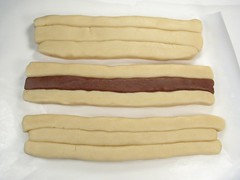 To make a batch of chocolate dough, reduce the flour by 1/4 cup and substitute 1/4 cup of cocoa powder. Also reduce the butter by a tablespoon and mix about a tablespoon of melted bittersweet chocolate into the cream cheese before adding it to the dough. Chilling the dough isn’t necessary, as you want it to be soft enough to be workable.
To make a batch of chocolate dough, reduce the flour by 1/4 cup and substitute 1/4 cup of cocoa powder. Also reduce the butter by a tablespoon and mix about a tablespoon of melted bittersweet chocolate into the cream cheese before adding it to the dough. Chilling the dough isn’t necessary, as you want it to be soft enough to be workable.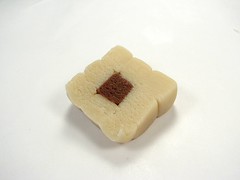
For the first block, you’ll need to roll out eight strips of one color and one of the contrasting color. After rolling them out, form each one into a square, then stack them to form a larger block with the contrasting color in the center. You’ll want to slice off the end of the stack to even it up. Use a sharp knife and cut carefully so you don’t squish the pattern.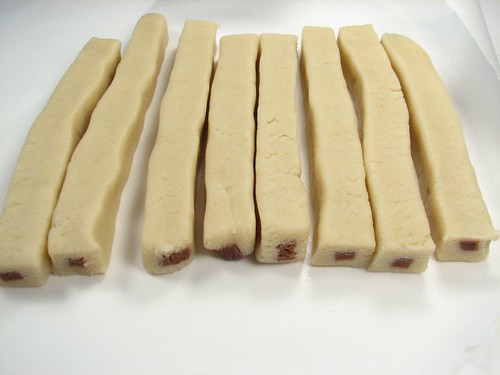
To draw the block out longer and thinner without disturbing the pattern, turn it over frequently. You can either squeeze the sides, then rotate, or press the top, then rotate. It helps to pull it out twice as long as it was, then cut in half, and repeat until you have eight equal pieces, each about as long as the original block. Parchment paper is a good work surface for this. Keep an extra sheet handy for when the one you’re working on gets too sticky.
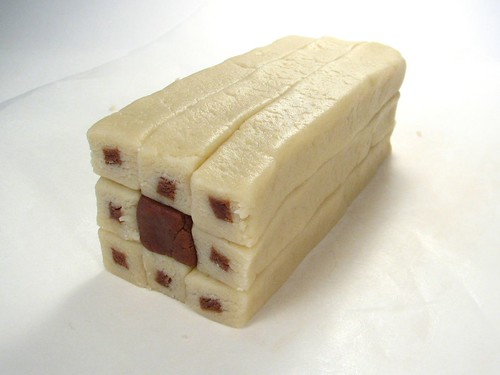
Roll out another length of the contrasting color, using the same amount of dough you used for the original pieces. Form it into a square, and stack the pieces up with the contrasting piece in the center again.
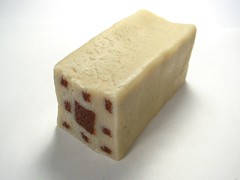
As you draw out the block, the edges of the individual sections will merge. If you want to cut samples of the different iterations, this is the time to do it – just after the edges have merged sufficiently. Again, lengthen it until it is twice as long, cut, and lengthen those pieces, cut again and repeat.
When you add another piece of contrasting color and stack everything up, the pieces will again be somewhat separate. You will want to draw it out a little smaller to merge the blocks before slicing.
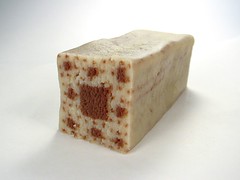 With three iterations, it’s now ready to slice. (If brave, feel free to try more iterations.) Chilling it would probably be a good idea, but if you’re impatient, be sure to rotate between slices to keep the pattern from getting too squished in any one direction. Slice carefully with a very sharp knife or a cheese wire.
With three iterations, it’s now ready to slice. (If brave, feel free to try more iterations.) Chilling it would probably be a good idea, but if you’re impatient, be sure to rotate between slices to keep the pattern from getting too squished in any one direction. Slice carefully with a very sharp knife or a cheese wire.
One final (but optional) step is to gently roll each cookie out to smooth the surface texture out.
Before…
and after baking.
Admire them while you can as they disappear quickly.
Fractal foods are not particularly common, but they are a lot of fun, like this fantastic fractal pizza. So, what fractal foods can you come up with? We’d love to see pictures of your fractal food in our flickr pool.




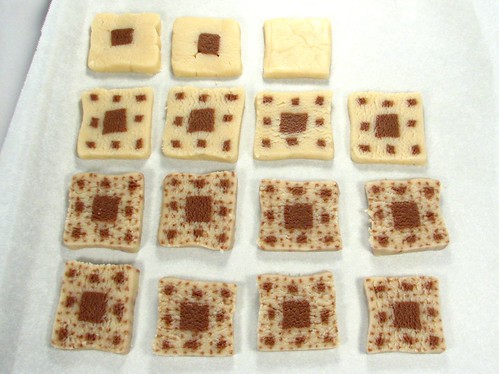
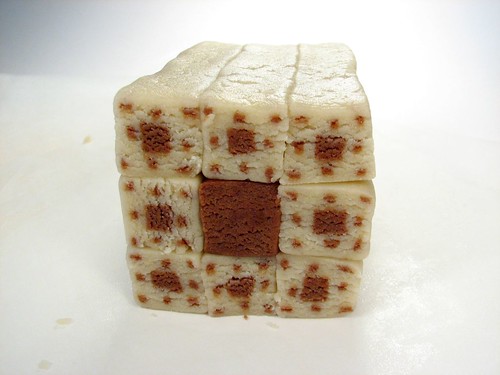
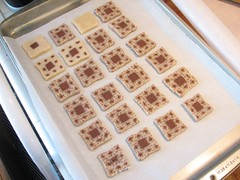

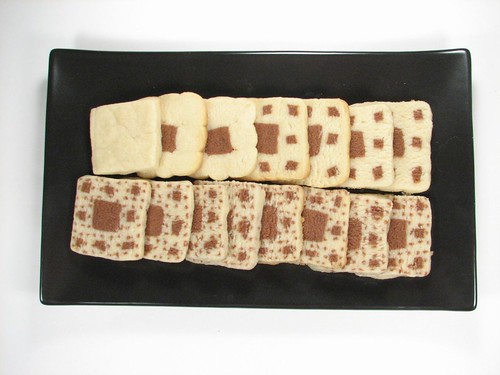
SO COOL. I’ve always wanted to make a Sierpinski quilt.
PattiS
It could be argued that, for the number of iterations shown, the flavors should have been reversed. However, with two more iterations, the balance shifts in favor of the chocoholic. The chocolate percentage approaches 100 as iterations approach infinity.
I never imagined cookies had a half a megapixel resolution.
BTW, I’m coming to live at your house.
Next recipe, Menger sponge cake! Completely calorie free.
Absolutely ingenious. And delicious, I bet.
You know about <A HREF="http://www.fourmilab.ch/images/Romanesco">fractal broccoli</A> ?
So, last week I was inspired by this, and made triangles. I’ve also converted the recipe into metric.
Thanks for a fantastic idea!
What a great idea. Thanks.
I call cookies like these Pixal Cookies. I usually use my Play-Doh press to make the shape, makes it a little easier.
MandaLyn
These are *not* pixel cookies– they are not made of pixels, and you can’t make these with a press– that’s not a fractal approach.
—
Windell H. Oskay
drwho(at)evilmadscientist.com
http://www.evilmadscientist.com/
I had a crack at these tonight. My mixture was a little too wet (too much butter) which made the stuff really difficult to work with. So it doesn’t really look like a Seretc. carpet, but they doo look like delicious biscuits. I’ll try again once these ones are gone.
brilliant
and fine point, dennis.
you know of course you can construct the carpet starting with a simple line segment, but that seems like a lot more dough rolling.
lets see the menger sponge cake.
I tried making these cookies, and they were so time-consuming but so good. Tastes better with homemade batter, and try not stretching it out and just making bigger ones to add on to make a really big cookie. Oh, and the final product is really satisfying after all the work! Tried baking them for a holiday cookie exchange and they were the hit of the party, if you know what I mean… Thanks so much for the great instructions, because they were amazing :)